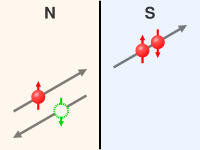
Andreev reflection
Encyclopedia

Scattering
Scattering is a general physical process where some forms of radiation, such as light, sound, or moving particles, are forced to deviate from a straight trajectory by one or more localized non-uniformities in the medium through which they pass. In conventional use, this also includes deviation of...
which
occurs at interfaces between a superconductor (S) and a normal state material (N). It is a charge-transfer process by which normal current in N is converted to supercurrent
Supercurrent
A supercurrent is a superconducting current, that is, electric current which flows without dissipation....
in S. Each Andreev reflection transfers a charge 2e across the interface, avoiding the forbidden single-particle transmission within the superconducting energy gap.
Overview
The process involves an electron (hole) incident on the interface from the normal state material at energies less than the superconducting energy gap. The incident electron (hole) forms a Cooper pairCooper pair
In condensed matter physics, a Cooper pair or BCS pair is two electrons that are bound together at low temperatures in a certain manner first described in 1956 by American physicist Leon Cooper...
in the superconductor with the retroreflection of a hole (electron) of opposite spin and momentum to the incident electron (hole), as seen in the figure. The barrier transparency is assumed to be high, with no oxide or tunnel layer which reduces instances of normal electron-electron or hole-hole scattering at the interface. Since the pair consists of an up and down spin
Spin (physics)
In quantum mechanics and particle physics, spin is a fundamental characteristic property of elementary particles, composite particles , and atomic nuclei.It is worth noting that the intrinsic property of subatomic particles called spin and discussed in this article, is related in some small ways,...
electron, a second electron (hole) of opposite spin to the incident electron (hole) from the normal state forms the pair in the superconductor, and hence the retroreflected hole (electron). Through time-reversal symmetry, the process with an incident electron will also work with an incident hole (and retroreflected electron).
The process is highly spin-dependent – if only one spin band is occupied by the conduction electrons in the normal-state material (i.e. it is fully spin-polarized), Andreev reflection will be inhibited due to inability to form a pair in the superconductor and impossibility of single-particle transmission. In a ferromagnet or material where spin-polarization exists or may be induced by a magnetic field, the strength of the Andreev reflection (and hence conductance of the junction) is a function of the spin-polarization in the normal state.
The spin-dependence of AR gives rise to the Point Contact Andreev Reflection (or PCAR) technique, whereby a narrow superconducting tip (often Nb, Sb or Pb) is placed into contact with a normal material at temperatures below the critical temperature of the tip. By applying a voltage to the tip, and measuring differential conductance between it and the sample, the spin polarization of the normal metal at that point (and magnetic field) may be determined. This is of use in such tasks as measurement of spin-polarized currents or characterizing spin polarization of material layers or bulk samples, and the effects of magnetic fields on such properties.
In an AR process, the phase difference between the electron and hole is −π/2 plus the phase of the superconducting order parameter.
Crossed Andreev Reflection
Crossed Andreev reflection, or CAR, also known as non-local Andreev reflection occurs when two spatially separated normal state material electrodes form two separate junctions with a superconductor, with the junction separation of the order of the BCS superconducting coherence length of the material in question. In such a device, retroreflection of the hole from an Andreev reflection process, resulting from an incident electron at energies less than the superconducting gap at one lead, occurs in the second spatially separated normal lead with the same charge transfer as in a normal AR process to a Cooper pair in the superconductor. For CAR to occur, electrons of opposite spin must exist at each normal electrode (so as to form the pair in the superconductor). If the normal material is a ferromagnet this may be guaranteed by creating opposite spin polarization via the application of a magnetic field to normal electrodes of differing coercivityCoercivity
In materials science, the coercivity, also called the coercive field or coercive force, of a ferromagnetic material is the intensity of the applied magnetic field required to reduce the magnetization of that material to zero after the magnetization of the sample has been driven to saturation...
.
CAR occurs in competition with elastic cotunelling or EC, the quantum mechanical tunneling of electrons between the normal leads via an intermediate state in the superconductor. This process conserves electron spin. As such, a detectable CAR potential at one electrode on the application of current to the other may be masked by the competing EC process, making clear detection difficult. In addition, normal Andreev reflection may occur at either interface, in conjunction with other normal electron scattering processes from the normal/superconductor interface.
The process is of interest in the formation of solid-state quantum entanglement
Quantum entanglement
Quantum entanglement occurs when electrons, molecules even as large as "buckyballs", photons, etc., interact physically and then become separated; the type of interaction is such that each resulting member of a pair is properly described by the same quantum mechanical description , which is...
, via the formation of a spatially separated entangled electron-hole (Andreev) pair, with applications in spintronics
Spintronics
Spintronics , also known as magnetoelectronics, is an emerging technology that exploits both the intrinsic spin of the electron and its associated magnetic moment, in addition to its fundamental electronic charge, in solid-state devices.An additional effect occurs when a spin-polarized current is...
and quantum computing.

